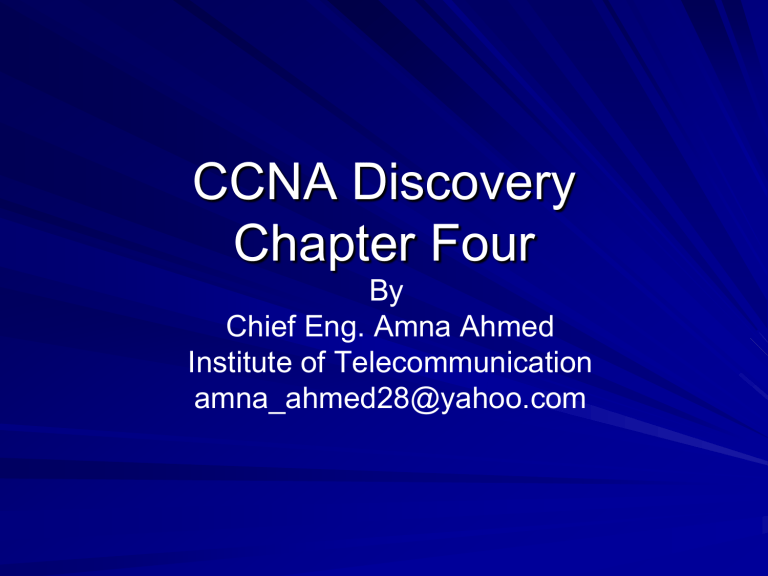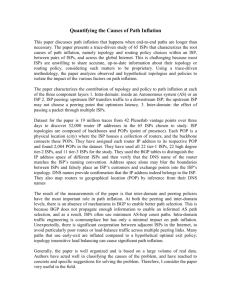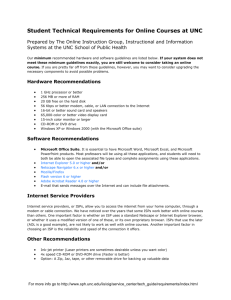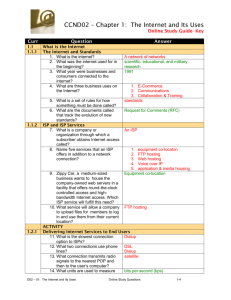Chapter 4

CCNA Discovery
Chapter Four
By
Chief Eng. Amna Ahmed
Institute of Telecommunication amna_ahmed28@yahoo.com
Chapter 4
Explain what the internet is
Every day millions of people exchange information through the
Internet - but what exactly is the Internet? The Internet is a worldwide collection of computer networks, cooperating with each other to exchange information using common standards. Through telephone wires, fiber optic cables, wireless transmissions and satellite links ,
Internet users can exchange information in a variety of forms.
The Internet is a network of networks that connects users in every country in the world. There are currently over one billion
Internet users worldwide.
Internet Service
Providers(ISPs
)
Internet must use an Internet Service Provider (ISP).
An ISP is a company that provides the connections and support to access the
Internet. It can also provide additional services such as Email and web hosting.
ISPs range in size from small to very large and differ in terms of the area they service. ISPs may provide limited services to a small geographical area or can have a wide variety of services and support entire countries with millions of customers. ISPs also differ in the types of connection technologies and speeds they offer. Examples of well known ISPs include
AOL, EarthLink, and Roadrunner.
The ISPs Relationship With the Internet
Individual computers and local networks connect to the ISP at a Point of
Presence ( POP ). A POP is the connection point between the ISP's network and the particular geographical region that the POP is servicing.
An ISP may have many Pops depending on its size and the area it services. Within an ISP, a network of high-speed routers and switches move data between the various Pops. Multiple links interconnect the Pops to provide alternate routes for the data should one link fail or become overloaded with traffic and congested.
ISPs connect to other ISPs in order to send information beyond the boundaries of their own network. The Internet is made up of very high-speed data links that interconnect ISP Pops and ISPs to each other. These interconnections are part of the very large, high capacity network known as the Internet Backbone.
Connecting to the ISP at the POP provides users with access to the ISP's services and the Internet.
Option for connecting to the Isp
Ps provide a variety of ways to connect to the Internet, depending on location and desired connection speed.
In a major city there are typically more choices for ISPs and more connection options than in a rural area. For example, cable Internet access is only available in certain metropolitan areas where cable TV service is available.
Remote areas may only have access via dial-up or satellite.
Each Internet access technology uses a network access device, such as a modem , in order to connect to the ISP. It may be built in to your computer or may be provided by the ISP.
The choice of Internet access technologies depends on availability, cost, access device used, media used and the speed of the connection .
Most of the technologies shown are used for both home and small business.
Leased lines are typically used for business and large organizations, but can be used to provide high speed connectivity in areas where cable or DSL are not available
ISP Levels of Service
Depending on the ISP and the connection technology, various services are available such as virus scanning, video on demand, and file storage. The contract with the ISP determines the type and level of services that are available. Most ISPs offer two different contract levels: home service or business class service.
Home service is normally less expensive than business services, and generally provides scaled-down services such as slower connection speed, reduced web space storage, and fewer email accounts. A typical home account may include a minimum of five email addresses with additional addresses being available for a fee.
When data is transferred, it is either uploaded or downloaded. Downloading refers to information coming from the Internet to your computer, while uploading indicates the reverse path, from your computer to the Internet. When the download transfer rate is different from the upload transfer rate, it is called asymmetric. When the transfer rate is the same in both directions, it is called symmetric
Asymmetric:
Most commonly used for the home.
Download speeds are faster than upload speeds.
Necessary for users that download significantly more than upload.
Most Internet users, especially those who use graphics or multimedia intensive web data, need lots of download bandwidth .
Symmetric:
Most commonly used for business or individuals hosting servers on the Internet.
Used when necessary to upload large amounts of traffic such as intensive graphics, multimedia, or video.
It can carry large amounts of data in both directions at equal rates.
Importance of the Internet protocol (IP)
For hosts to communicate on the Internet, they must be running Internet
Protocol (IP) software. The IP protocol is one of a group of protocols that are collectively referred to as TCP/IP (Transmission Control Protocol /
Internet Protocol). The Internet Protocol (IP) uses packets to carry data
Each IP packet must contain a valid source and destination IP address. Without valid address information, packets sent will not reach the destination host. Return packets will not make it back to the original source.
An IP packet has a header at the beginning which contains the source and destination IP addresses. It also contains control information that describes the packet to network devices, such as routers, it passes through and also helps to control its behavior on the network. The IP packet is sometimes referred to as a datagram.
IP addresses must be unique on the Internet. There are organizations responsible for controlling the distribution of IP addresses so that there is no duplication. ISPs obtain blocks of IP addresses from a local, national or regional Internet registry (RIR). It is the responsibly of the ISPs to manage these addresses and assign them to end users.
How ISPs Handle packets
Before being sent on the Internet, messages are divided into packets . IP packet size is between 64 to 1500 bytes for Ethernet networks, and contains mostly user data.
Downloading a single 1 MB song would require over 600 packets of 1500 bytes. Each individual packet must have a source and destination IP address.
When a packet is sent across the Internet, the ISP determines whether the packet is destined for a local service located on the ISP network, or a remote service located on a different network.
Every ISP has a control facility for their network, known as the Network Operations
Center (NOC). The NOC usually controls traffic flow and houses services such as email and web hosting
Internet Cloud
A diagram that shows all network devices and their interconnections would be very complex. Additionally, the final routing path between source and destination is not usually important, only that the source is able to communicate with the destination. Therefore, in network diagrams a cloud is often used to represent the Internet or any other complex network,
Device in Internet Cloud
Devices that provide connectivity to end-users must match the technology used by the end-user to connect to the ISP. For example, if the end-user is using DSL technology to connect, the ISP must have a DSL Access Multiplexer
(DSLAM) to accept these connections. For cable modems to connect, the ISP must have a Cable Modem Termination System (CMTS). Some ISPs still accept analog calls through modems and have banks of modems to support these users. ISPs that provide wireless access have wireless bridging equipment.
Common Network Cables
Twisted Pair Cables
Coaxial Cable
Fiber Optic Cables
Cabling Standards
Cabling standards are a set of specifications for the installation and testing of cables. Standards specify types of cables to use in specific environments, conductor materials, pinouts, wire sizes, shielding, cable lengths, connector types and performance limits.
UTP Cables
Twisted pair cable is most commonly used in network installations. The
TIA/EIA organization defines two different patterns, or wiring scheme, called
T568A and T568B. Each wiring scheme defines the pinout, or order of wire connections, on the end of the cable.
Identify and describe the cross-over and straight through cable pinouts and color codes
UTP Cable Termination
UTP and STP cable is usually terminated into an RJ-45 connector
The RJ-45 jack has eight conductors, and is wired according to either T568A or T568B. At the patch panel a device known as a punchdown tool is required to push the wires into the connector.
The wires should be matched up to the appropriate insulation displacement connector (IDC) by color before punching them down. The punchdown tool also cuts off any excess wire.
A punchdown tool is not required to terminate most wall jacks. To terminate these connectors the cables are untwisted and placed into the appropriate IDC. Placing the cap on the jack pushes the cables into the IDC and cuts through the insulation on the wires.
Describe how to test cable termination and functionality (Cable testing).
Describe how to test cable termination and functionality (Cable testing).
The cable tester is used to perform initial diagnostics. The first test usually is called a continuity test and it verifies that there is end-to-end connectivity. It can also detect common cabling faults such as opens and shorts.
Attenuation , also commonly referred to as insertion loss, is a general term that refers to the reduction in the strength of a signal. Attenuation is a natural consequence of signal transmission over any medium. Attenuation limits the length of network cabling over which a message can be sent.
Crosstalk is the leakage of signals between pairs. If this is measured near the transmitting end it is termed near-end crosstalk ( NEXT ). If measured at the receiving end of the cable it is termed far-end crosstalk ( FEXT ). Both forms of crosstalk degrade network performance and are often caused by untwisting too much cable when terminating.
Summary
The Internet is a worldwide collection of computer networks, accessed through ISPs.
Internet Protocol (IP) controls the structure and addressing of data packets for transport through the
Internet cloud.
ISP Network Operations Centers (NOCs) utilize highend, high-speed devices with redundancy.
Home networks feature multi-function devices which perform switching and routing.
Networks use physical cabling media which must conform to standards in construction and termination.
Cabling best practices are designed to reduce attenuation and crosstalk.





